 |
Title: GMO Food
|
Newsletters
Title: Recent Biotechnological Applications in India
EDITED BY:
Prof. S. C. Santra, A. Mallick
PUBLISHED BY:
ENVIS Centre on Environmental Biotechnology
(Supported by Ministry of Environment & Forest, Govt. of India)
KeyWords: Environmental Biotechnological Application
Year of Publication: 2016
Language: English
Pages: 187
Details:
Biotechnology is the third wave in biological science and represents such an interface of basic and applied sciences, where gradual and subtle transformation of science into technology can be witnessed. Biotechnology is defined as the application of scientific and engineering principals to the processing of material by biological agents to provide goods and services. Biotechnology comprises a number of technologies based upon increasing understanding of biology at the cellular and molecular level. During the last decade the advancements in biology have led to the development newer areas like, cellular engineering, biochips and biomaterial science, stem cells, nanobiotechnology etc. Biotechnology is a vast subject and covers Gene and genome analysis: analysis of genes and gene networks showing the potential for industrial application; gene expression studies; biotech plant breeding, e.g. marker assisted breeding. Transgenic technologies: Production and analysis of transgenic crops; gene insertion studies; gene silencing; factors affecting gene expression; posttranslational analysis; molecular farming; field trial analysis; commercialisation of modified crops; safety and regulatory affairs Functional genomics: bioinformatics; gene function studies for applied uses Comparative genomics: applications to crop species; use of current crop databases
The path from a test tube to the field is not a straight highway. Both intellectual and financial resources should be realized before new discoveries pave their way to industrial applications. In conclusion, biotechnology has also proved to be extremely productive and innovative and 21st century should be the century of biotechnology.

Title: New Frontiers of Environmental Biotechnological Application
EDITED BY:
Prof. S. C. Santra
PUBLISHED BY:
ENVIS Centre on Environmental Biotechnology
(Supported by Ministry of Environment & Forest, Govt. of India)
KeyWords: Environmental Biotechnological Application
Year of Publication: 2007
Language: English
Pages: 209
Details:
Environmental biotechnology is the application of all components of biotechnology to solve environmental problems. The prime target of this science is the abatement of pollution through bioremedation/ biotreatment or supporting as resources for human use in non-polluting ways. It can also help in cleaner production of existing products. On the whole it encompasses aspects of natural resources management, the treatment of waste and control of pollution. Thus the major areas of understanding are environmental pollution abatement through biodegradation, biotranformation, bioaccumulation of toxicity like organics, metals, oil & hydrocarbons, dyes, detergents etc., Energy management through production nonconventional nonpolluting energy like biodeasel methanol, biogass, biohydrogen etc., Agricultural application of biofertilizer, biopesticides, or bioorganics of multiple users, Recovery of resources from toxic or nontoxic wastes through biotechnological approach, Biosensor approach of pollution monitoring and several other allied issues.
![]() New forntiers of environmental Biotechnological application.pdf
New forntiers of environmental Biotechnological application.pdf
Newsletters
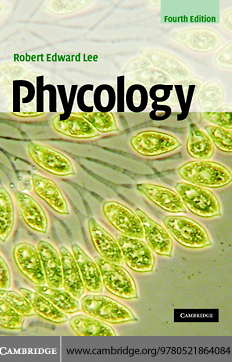 Title: Phycology (Fourth edition)
Title: Phycology (Fourth edition)
Author:
Robert Edward Lee,
Colorado State University, USA
Publishers: CAMBRIDGE UNIVERSITY PRESS,
Cambridge, New York, Melbourne
Year of Publication: 2008
Language: English
Pages: 561
Details:
Phycology or algology is the study of the algae. The word phycology is derived from the Greek word phykos, which means “seaweed.” The term algology, described in Webster’s dictionary as the study of the algae, has fallen out of favor because it resembles the term algogenic which means “producing pain.” The algae are thallophytes (plants lacking roots, stems, and leaves) that have chlorophyll a as their primary photo synthetic pigment and lack a sterile covering of cells around the reproductive cells. This definition encompasses a number of plant forms that are not necessarily closely related, for example, the cyanobacteria which are closer in evolution to the bacteria than to the rest of the algae.
Newsletters

Title: Fundamental Principles of Bacteriology (SECOND EDITION, SIXTH IMPRESSION)
Author:
A. J. SALLE, B.S., M.S., PH.D., Associate Professor of Bacteriology,
University of California
Publishers: McGRAW-HILL BOOK COMPANY, INC.,
NEW YORK AND LONDON
Year of Publication: 1943
Language: English
Pages: 642
Details: Bacteria are widely distributed in nature, being found nearly everywhere. They are found in the soil, air, water, foods, in decaying organic matter of all kinds, on the body surface, within the intestinal tract of man and animals, etc. The numbers vary from one place to another, depending upon the environmental conditions.
Newsletters
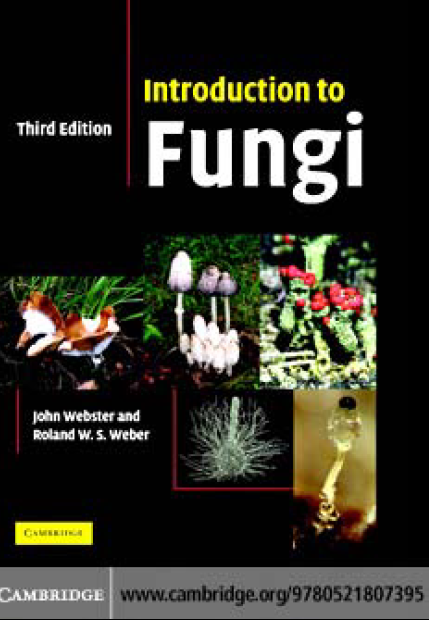 Title: Introduction to Fungi
Title: Introduction to Fungi
Author:
JohnWebster,
University of Exeter
and RolandWeber,
University of Kaiserslautern
Publishers: CAMBRIDGE UNIVERSITY PRESS,
Cambridge, New York
Year of Publication: 2007
Language: English
Pages: 875
Details:
About 80 000 to 120 000 species of fungi have been described to date, although the total number of species is estimated at around 1.5 million (Hawksworth, 2001; Kirk et al., 2001). This would render fungi one of the least-explored biodiversity resources of our planet. It is notoriously difficult to delimit fungi as a group against other eukaryotes, and debates over the inclusion or exclusion of certain groups have been going on for well over a century.
Newsletters
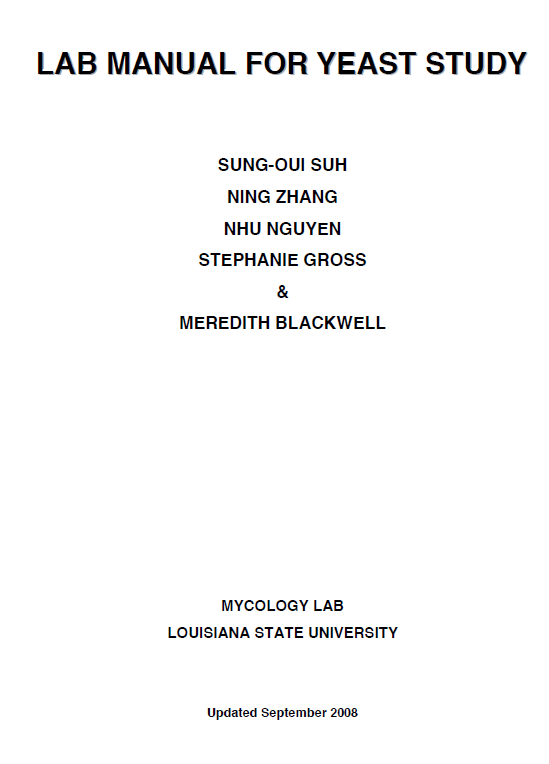
Title: LAB MANUAL FOR YEAST STUDY
Author:SUNG-OUI SUH,
NING ZHANG,
NHU NGUYEN, STEPHANIE GROSS,
& MEREDITH BLACKWELL
Publishers: MYCOLOGY LAB,
LOUISIANA STATE UNIVERSITY
Year of Publication: 2008
Language: English
Pages: 642
Details:
A. Collection of beetles
Preparation: paper bags, Ziplock bags, pencil, knife, Aspirator, vials, white sheet
Important points:
1. Host information is very important. Keep the host mushroom too.
2. Insects ideally should be put in separate containers (Ziplock bags or plastic vial or box) and
put into the same paper bag containing the mushroom host.
3. Take notes for the collection date, place, and host information and put in the paper bag with
the insect and mushroom host.
4. Sort out beetles from mushrooms ASAP because they do escape.
5. Keep the beetles for 3 days in a clean container with slightly moistened filter paper so that
surface debris is removed.
Newsletters

Title: Genetics, Molecular and Cell Biology of Yeast
Author: Roger Schneiter
Publishers: Universite De Fribourg Suisse
Year of Publication: 2004
Language: English
Pages: 86
Details:Yeast are unicellular fungi (http://www.doctorfungus.org/). The precise classification uses the characteristics of the cell, ascospore and colony. Physiological characteristics are also used to identify species. One of the more well known characteristics is the ability to ferment sugars for the production of ethanol. Budding yeasts are true fungi of the phylum Ascomycetes, class Hemiascomycetes. The true yeasts are separated into one main order Saccharomycetales.
PhD eThesis
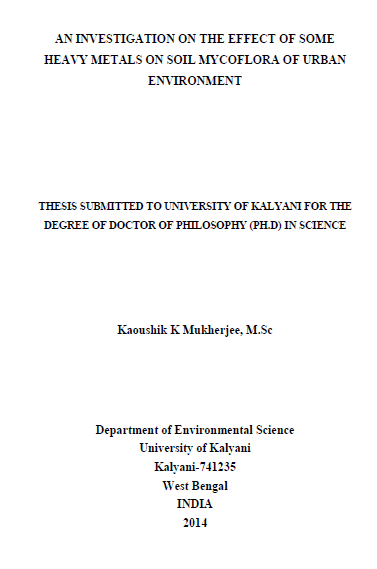 Title: An investigation on the effect of some heavy metals on soil mycoflora of urban environment
Title: An investigation on the effect of some heavy metals on soil mycoflora of urban environment
Supervised by:
Prof. S. C. Santra
Year of Publication: 2014
Language: English
Pages: 150
Details:
Fungi are ubiquitous in natural environments and important in industrial processes. A range of morphologies are found from unicellular yeasts to polymorphic and filamentous fungi, many of which have complex macroscopic fruiting bodies. Their most important roles are as decomposers of organic materials, with concomitant nutrient cycling, as pathogens and symbionts of animals and plants and as spoilage organisms of natural and synthetic materials like wood, paint, leather, food and fabrics.
The fungi are utilized as producers of economically important substances, e.g. ethanol, citric acid, antibiotics, polysaccharides, enzymes and vitamins. The study of the interaction between toxic metals and fungi has long been of scientific interest. This is because metal toxicity has been, and remains the basis of many fungicidal preparations used in the control of plant pathogens and to preserve natural and synthetic materials (Horsfall, 1956; Ross, 1975). Early work often had a phytopathological perspective relating to the assessment of toxicity (Somers, 1961).
![]() An investigation on the effect of some heavy metals on soil mycoflora of urban environment
An investigation on the effect of some heavy metals on soil mycoflora of urban environment
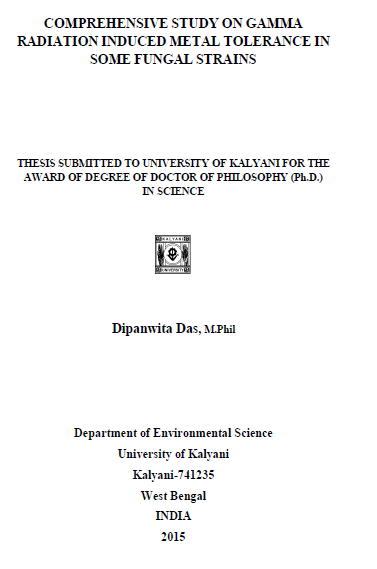 Title: Comprehensive study on gamma radiation induced metal tolerance in some fungal strains
Title: Comprehensive study on gamma radiation induced metal tolerance in some fungal strains
Supervised by:
Prof. S. C. Santra, Professor, University of Kalyani & Dr. A. Chakraborty, Scientist F, University Grants Commission- Department of Atomic Energy Consortium for
Scientific Research (UGC-DAE CSR), Kolkata Centre
Year of Publication: 2015
Language: English
Pages: 229
Details:
Environmental pollution, a global scenario
Substantial increase in agricultural, industrial and technological growth, in addition to population escalation resulted in deterioration of environmental quality in a global scale. Rapidly growing cities, more traffic on roads, growing energy consumption and waste production together with lack of strict implementation of environmental regulation are increasing the discharge of pollutants into air, water, and soil (Agarwal, 2005). Air pollution is the result of emissions from a variety of sources, mainly stationary, industrial and domestic fossil fuel combustion, and petrol and diesel vehicle emissions (Brulfert et al., 2005; Parra et al., 2006). Fossil fuels, the primary source of energy consumption, are the greatest source of ambient air pollution, producing nitrogen oxides, sulphur-oxides, dust, soot, smoke, and other suspended particulate matter. Most Asian cities cannot meet the terms with the World Health Organisation (WHO) air quality guidelines or the US Environmental Protection Agency standards (USEPA); except some cities of developed countries such as Singapore, Taiwan, and Japan
![]() Comprehensive study on gamma radiation induced metal tolerance in some fungal strains
Comprehensive study on gamma radiation induced metal tolerance in some fungal strains
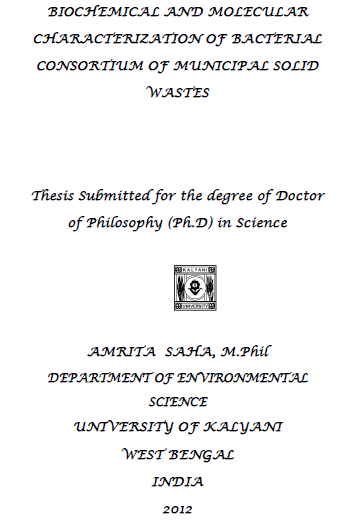 Title: Biochemical and Molecular characterization of bacterial consortium of municipal solid wastes
Title: Biochemical and Molecular characterization of bacterial consortium of municipal solid wastes
Supervised by:
Prof. S. C. Santra, Professor, University of Kalyani
Year of Publication: 2012
Language: English
Pages: 188
Details:
Modern times have plagued the humanity with new problems due to industrialization and simultaneous population explosion. Rapid industrialization and population explosion in India has led to the migration of people from villages to cities, which generate thousands of tons of Municipal Solid Waste (MSW) daily. Municipal solid waste consists of household waste, construction and demolition debris, sanitation residue and waste from streets. This garbage is generated mainly from residential and commercial complexes.
![]() Biochemical and Molecular characterization of bacterial consortium of municipal solid wastes
Biochemical and Molecular characterization of bacterial consortium of municipal solid wastes
![]() COMMISSION ON GENETIC RESOURCES FOR FOOD AND AGRICULTURE
COMMISSION ON GENETIC RESOURCES FOR FOOD AND AGRICULTURE



